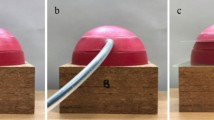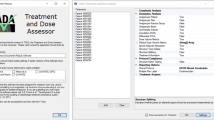Abstract
The technical feasibility of Partial Breast Irradiation (PBI) using external beam radiotherapy depends on the ratio between the evaluation planning target volume (PTV_eval) and the whole breast volume (“PBI volume ratio” = PVR). We aimed to develop a simple method to determine PVR using measurements performed at the time of the planning CT scan. A PVR calculation tool was developed using a Microsoft Excel spreadsheet to determine the PTV from three orthogonal dimensions of the seroma cavity and a given margin on the CT scans. The breast volume is estimated from the separation and breast height in five equally spaced CT slices. The PTV_eval and whole breast volume were determined for 29 patients from two centres using the spreadsheet calculation tool and compared to volumes delineated on computerised treatment planning systems. Both the PTV_eval and whole breast volumes were underestimated by approximately 25% using the spreadsheet. The resulting PVRs were 1.05±0.35 (mean ±1SD) times larger than the ones determined from planning. Estimations of the PVR using the calculation tool were achievable in around 5 minutes at the time of CT scanning and allow a prompt decision on the suitability of the patients for PBI.
Similar content being viewed by others
References
Sarin, R.partial-breast treatment for early breast cancer: emergence of a new paradigm. Nat. Clin. Pract. Oncol. 2, 40–47, 2005.
Polgar, C., Major, T., Fodor, J., et al.High-dose-rate brachytherapy alone versus whole breast radiotherapy with or without tumor bed boost after breast-conserving surgery: seven-year results of a comparative study, Int. J. Radiat. Oncol. Biol. Phys. 60, 1173–1181, 2004.
Bensaleh, S., Bezak, E., Borg, M.Review of MammoSite brachytherapy: Advantages, disadvantages and clinical outcomes, Acta Oncol. 2008, 1–8.
Vaidya, J.S., Baum, M., Tobias, J.S., et al.Targeted intraoperative radiotherapy (TARGIT) yields very low recurrence rates when given as a boost, Int. J. Radiat. Oncol. Biol. Phys. 66, 1335–1338, 2006.
Moon, S.H., Shin, K.H., Kim, T.H., et al.Dosimetric comparison of four different external beam partial breast irradiation techniques: Three-dimensional conformal radiotherapy, intensity-modulated radiotherapy, helical tomotherapy, and proton beam therapy. Radiother. Oncol. 90, 66–73, 2009.
Sanders, M.E., Scroggins, T., Ampil, F.L., et al.Accelerated partial breast irradiation in early-stage breast cancer, J. Clin. Oncol. 25, 996–1002, 2007.
Vicini, F., Winter, K., Straube, W., et al.A phase I/II trial to evaluate three-dimensional conformal radiation therapy confined to the region of the lumpectomy cavity for Stage I/II breast carcinoma: initial report of feasibility and reproducibility of Radiation Therapy Oncology Group (RTOG) Study 0319, Int. J. Radiat. Oncol. Biol. Phys. 63, 1531–1537, 2005.
Sher, D.J., Wittenberg, E., Taghian, A.G., et al.Partial breast irradiation versus whole breast radiotherapy for early-stage breast cancer: a decision analysis, Int. J. Radiat. Oncol. Biol. Phys. 70, 469–476, 2008.
Vicini, F.A., Remouchamps, V., Wallace, M., et al.Ongoing clinical experience utilizing 3D conformal external beam radiotherapy to deliver partial-breast irradiation in patients with early-stage breast cancer treated with breast-conserving therapy, Int. J. Radiat. Oncol. Biol. Phys. 57, 1247–1253, 2003.
Oliver, M., Chen, J., Wong, E., et al.A treatment planning study comparing whole breast radiation therapy against conformal, IMRT and tomotherapy for accelerated partial breast irradiation, Radiother. Oncol. 82, 317–323, 2007.
Sher, D.J., Wittenberg, E., Suh, W.W., et al. Partial-Breast Irradiation Versus Whole-Breast Irradiation for Early-Stage Breast Cancer: A Cost-Effectiveness Analysis, Int. J. Radiat. Oncol. Biol. Phys. e-pub 10/2008.
Budrukkar, A.N., Sarin, R., Shrivastava, S.K., et al.Cosmesis, late sequelae and local control after breast-conserving therapy: influence of type of tumour bed boost and adjuvant chemotherapy, Clin. Oncol. (R. Coll. Radiol.) 19, 596–603, 2007.
Sauer, R., Sautter-Bihl, M.L., Budach, W., et al.Accelerated partial breast irradiation: consensus statement of 3 German Oncology societies, Cancer 110, 1187–1194, 2007.
Wong, E.K., Truong, P.T., Kader, H.A., et al.Consistency in seroma contouring for partial breast radiotherapy: impact of guidelines, Int. J. Radiat. Oncol. Biol. Phys. 66, 372–376, 2006.
Petersen, R.P., Truong, P.T., Kader, H.A., et al.Target volume delineation for partial breast radiotherapy planning: clinical characteristics associated with low interobserver concordance, Int. J. Radiat. Oncol. Biol. Phys. 69, 41–48, 2007.
Author information
Authors and Affiliations
Corresponding author
Rights and permissions
About this article
Cite this article
Kron, T., Willis, D., Miller, J. et al. A spreadsheet to determine the volume ratio for target and breast in partial breast irradiation*. Australas. Phys. Eng. Sci. Med. 32, 98–104 (2009). https://doi.org/10.1007/BF03178635
Received:
Accepted:
Issue Date:
DOI: https://doi.org/10.1007/BF03178635




